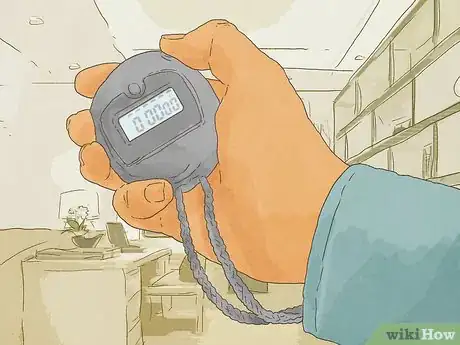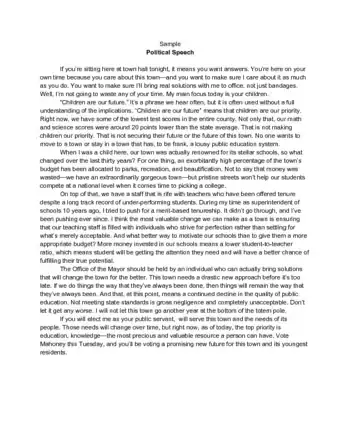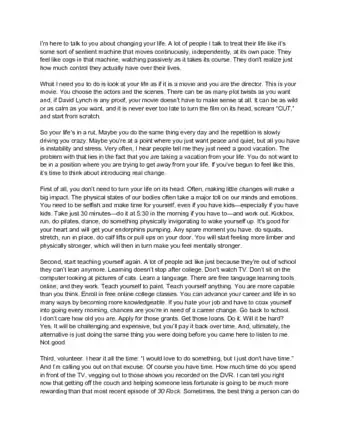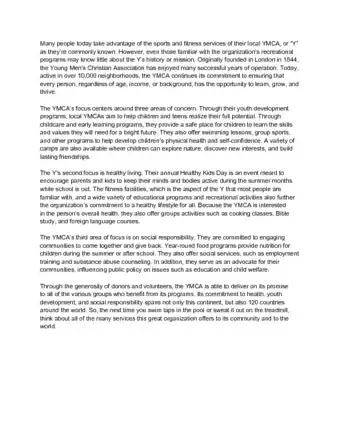This article was co-authored by Deb DiSandro. Deb DiSandro is the Owner of Speak Up On Purpose, an organization dedicated to improving and teaching public speaking. Deb has over 30 years of experience as a national speaker and has presented at the Erma Bombeck Writer’s Conference and the National Society of Newspaper Columnists. She was awarded the National Speakers Association Member of the Year 2007 and has been published in Writer's Digest, Daily Herald, Women's Day, and Better Homes & Gardens.
There are 7 references cited in this article, which can be found at the bottom of the page.
This article has been viewed 262,074 times.
It's time to tackle what people are afraid of more than death: public speaking. Luckily, there are several strategies to help you get through this nerve-wracking event. Preparation is key and can help you speak confidently, no matter what the topic!
Steps
Preparing the Speech
-
1Pick your message. Your speech should be able to summed up in a sentence, maybe two. This is what your speech really boils down to: it's what you'll start off with and what you'll return to at the end. It's simple and people can stick to it. And it's easier for you, too![1]
- So what's yours? Did your teacher give you a specific topic to cover? If so, what's your stance? Or is it more personal? Two or three personal stories with a connecting theme can be quite the vivid speech.
-
2Know your audience. This will determine the entirety of your speech. You wouldn't deliver the same speech to four-year-olds as you would to CEOs! So know your audience. Here are a few things to consider:[2]
- Who are they? Age? Gender? Beliefs?
- How much do they know about your topic? This will determine the amount of complicated language you can use (hint: if they don't know much, don't use it!).
- Why are they there? To be taught something? Because they have to be? Because they're genuinely interested? If your audience has to be there, try to create an opening that’s sympathetic, supportive, and fun to get them engaged.
- How long have they been there? If you're 17th of 18th speeches, take that into account!
Advertisement -
3Don't ruminate about negative thoughts. Ask yourself, what's the worst that can happen? People will give you weird looks for not giving a speech according to their "expectations". Not more than that. Think of what you will gain, overcoming the fear of public speaking.
-
4Research your subject. If your subject is you, congratulations! You probably already know you like the back of your hand (or arm or leg, but probably not head). But if it's not, get to researching. The pros and the cons! If people can poke holes in your argument, that's not a very effective speech.
- Have at least three points to support your message (that one succinct sentence you're working with). Address the counterargument, but don't focus on it.
- Only complicate it as much as your audience can tolerate. Stay away from jargon and technical terms if it's gonna leave your listeners scratching their heads and feeling out of place.
-
5Use stories, humor and metaphors. A speech that's full of dull, meaningless statistics and facts probably won't get you anywhere with any audience. The human mind will tune out in seconds if that's all it hears. Instead, opt for stories—which are easier to follow and keep your audience engaged—and make them vivid with things like metaphors and antithesis. The more vivid a picture you can paint, the better.
- Self-deprecating humor (making fun of yourself) has its place. Again, this comes down to knowing your audience and the format of your speech. A best man speech? Totally appropriate. Addressing the president of your company about budget locations? Maybe not.
- Antithesis is about using opposites. Clinton said, "I want to nominate a man who’s cool on the outside but who burns for America on the inside" in his speech about Barack Obama.[3] Pretty vivid stuff.
-
6Use striking adjectives, verbs and adverbs. More about being vivid! Take the sentence "The fishing industry is bad" and change it to "The fishing industry's practices are egregious." Even something as simple as "We can solve the problem," to "We can eradicate the problem" is more memorable. Your audience might not remember exactly what you said, but they'll remember the emotion you invoked within them.[4]
- Opt for strong, descriptive verbs instead of adverbs.
- Think active, too. "When we have the manpower, we can force change," is much more powerful when it's turned around -- "We can force change when we have the manpower." Make 'em sit up in their seats, you know?
-
7Jump right in. When a speech goes viral on YouTube, you know it's good -- and Steve Jobs' 2005 address to Stanford grads did just that. He started with, "Today I want to tell you three stories from my life. That’s it. No big deal. Just three stories."[5] Boom. Hooked.
- So no hemming and "hawwing", no apologizing, no "I wondered...," no "Thank yous," just brass tacks. Get right in there. Don't talk about painting -- get right in there and start creating an image for them. They're there for your speech, not how you felt about it or how you feel now. Hook 'em from the get-go by starting strong outta the gate.
-
8Write it out. Forming a speech in your head is a lot of work. Write it out, see how it transitions from point to point, if it covers all your bases, and if it really says what you set out to say. If it doesn't, revamp till it does!
- Take notes on paper or using an app as ideas come to you.
- You should have a clear introduction, body, and conclusion. The introduction and conclusion should both be brief and to the point, the conclusion being a reiteration of the intro. And the body? Well, that's everything else.
Practicing the Speech
-
1Write down your main points. Now that you have everything you want to say figured out (and hopefully on paper), write down your main points. Take this notecard and see if you can cover everything just from looking at it. How does it flow? What parts are you less convinced by yourself on?
- Get to the point where you're comfortable delivering it just with the notecard. The more comfortable you are with the speech, the more it'll show when you're delivering it.
-
2Memorize it. Alright, so this isn't super necessary, but it's definitely a good idea. If you have it memorized, you can make eye contact with your audience and worry about the icing on the cake, like gestures and inflection. Don't stress if you don't have enough time -- but if you do, take advantage of it.
- Be sure to memorize the most important aspects, such as a funny story, quote, or memorable turn of phrase so you can deliver them exactly as you imagined.
- This doesn't mean that you have to go out there unarmed. No, you'll be taking your notecard with you! If your mind blanks, you can take a look-see at it and go right where you need to. You ran over it with the notecard 10 times for this reason.
-
3Deliver it to someone. This is a grand idea for a couple of reasons:[6]
- Delivering it to someone helps you get used to someone looking at you while you're talking. Public speaking can be pretty terrifying, so having a practice audience will help calm your nerves.
- Have them actually pay attention. At the end of your speech, ask them what questions popped up in their mind. Were there any holes in your argument? Or did anything confuse them?
-
4Practice in front of the mirror and in the shower. Really, you should be practicing wherever you can. But these two spots will be particularly useful:
- Practice in front of the mirror so you can see your body language. What gestures work where? How do you feel about the pauses and what do you do during them?
- Practice in the shower because it's probably one of the few times during the day where you can mindlessly go over it. Does your mind blank on any part? If so, review it.
- Practice while you’re doing other things as well, like driving, walking your dog, or mowing the lawn.
-
5Time it. You probably have some idea of how long your speech should be -- either you were given a specific time slot or you were given a length requirement for the speech. Try to get it comfortably above the minimum and comfortably below the maximum -- that way if you accidentally speed up or slow down, you're still golden.
Delivering the Speech
-
1Think about your posture and body language. Standing like you have a fig leaf over your crotch is not the way to give a captivating speech. Nor should you go the opposite way and lean over the podium. It's best to stand straight, feet shoulder width apart, and use your hands as naturally as possible.[7]
- Your speech conveys a certain amount of emotion, right? (Correct answer: Yes.) Take those moments and move with them. You use your hands every day to express emotion -- this speech is no different. You're still communicating to people, just on a bigger scale. Though the scale is different, the gestures remain the same.
- For a great example of how to move on stage and use your hands while speaking, check out Bryan Stevenson's Ted Talk on Equal Justice.
-
2Use props. Have you heard about that TED talk where the woman is talking about schizophrenia and her own brain hemorrhage? No? Well, have you heard about that TED talk where the woman is talking about schizophrenia and her own brain hemorrhage and then she whips out a real human brain, spinal cord and all? You can hear the audiences jaws dropping in the video. Talk about painting a vivid picture.
- This should be used carefully, though. Don't whip out a different prop every sentence. Stick to one really effective prop, like the brain. Telling a story about your dad's last burning building he ran into? Take out his burned firefighter helmet. Talking about the time you ran into Will Ferrell at your local Starbucks? Whip out your autographed grande, coffee-stained cup when you get to the part about how you fainted after asking. Use them sparingly, but effectively.
-
3Know when and how to use pictures. A powerpoint can be a great addition to a speech (for certain topics, at least). Just make sure you use them to your advantage! You want them to listening to you, not awe-struck by the pretty pictures. Take the time to practice delivering your speech while presenting the powerpoint in order to get the timing and technical aspects down.[8]
- Use graphs to illustrate your points, especially if they're hard to understand. Pictures can be more memorable than just being told factoid, regardless of how pivotal it may be.
- Don't face the pictures when you're talking! You know what's on there -- keep delivering the speech to your audience, not the screen.
-
4Select people in your audience, don't scan. A lot of people are under the impression scanning the audience is ideal -- and if that makes you nervous, just sort of scan the back wall. No! Resist! Instead, think of it as a one-on-one conversation. Make eye contact with a person over here, a person over there, etc. Draw them in one at a time instead of making them all feel glossed over.[9]
-
5Vary your tone. In general, sure, you should talk at a calm, understandable rate and speak with clarity. This should be your go-to. But to keep your audience awake and to keep your speech dynamic, vary it up. The parts you feel passionate about should be clearly emphasized! Speak loudly and with vigor! Pound your fist if you need to! And then there are parts that will feel more like a lullaby. And even parts that require pauses to let the emotion set in...AND THEN RAMPED BACK UP. It's a lot more effective verbally than over text. You get it.[10]
- Show emotion in your tone, too. Don't be afraid to chuckle a bit or show a bit of grief or frustration. You're human. Your audience is looking for a human connection, not a robot spitting words at them.
-
6Don't forget about pauses! There's just as much power in the pauses as there is in the words. Think about the sentence, "Dihydrogen monoxide killed 50 million people last year. 50 million. Let that sink in." Now think about the sentence with pauses after each period. Gets a little more serious, doesn't it?
- Take your speech and literally write in the pauses if it'll help you. Draw a big ol' slash through the text to indicate a break. Once you have it down, you'll be able to feel where the pauses will go.
-
7Conclude by restating your message and saying a simple, "Thank you." You've gone through the speech, no one's died, and now it's time for your conclusion. Keep it to the point, lock eyes with the audience, thank them, smile, and get off the stage.
- Take a deep breath. You did it. Next time you'll be giving a speech on how to give speeches. What were you so nervous about in the first place?
Sample Speeches
Community Q&A
-
QuestionWhat type of body language should I have?
 Mathematitian2020Community AnswerWhile giving a speech, your posture should be straight and your walking should be steady. If you have to stand in one place or sit somewhere, you can hold up your chin high. These signs show confidence. Always smile kindly and answer to every question even for the most annoying person. Make sure, that while giving a speech, your voice doesn't waver. Wavering of the voice shows a lack of confidence.
Mathematitian2020Community AnswerWhile giving a speech, your posture should be straight and your walking should be steady. If you have to stand in one place or sit somewhere, you can hold up your chin high. These signs show confidence. Always smile kindly and answer to every question even for the most annoying person. Make sure, that while giving a speech, your voice doesn't waver. Wavering of the voice shows a lack of confidence. -
QuestionHow do I start a speech about a person?
 Anonymous queenCommunity AnswerStart with a short quote from the person. You also could start with listing the biggest achievement of the person.
Anonymous queenCommunity AnswerStart with a short quote from the person. You also could start with listing the biggest achievement of the person. -
QuestionCan you give me an example of how I can make my intro be attractive and beautiful?
 Community AnswerI learned that you should start by asking a question. For Example: your presentation is on the Grand Canyon. Ask something like: "Have you ever wondered how the Grand Canyon was formed? If it was like that before?" Or something like that.
Community AnswerI learned that you should start by asking a question. For Example: your presentation is on the Grand Canyon. Ask something like: "Have you ever wondered how the Grand Canyon was formed? If it was like that before?" Or something like that.
Things You'll Need
- Pen
- Paper
- Source material
- Notecard(s)
- Mirror
- Tape recorder
- Audience
References
- ↑ https://westsidetoastmasters.com/resources/powerspeak/ch03.html
- ↑ https://westsidetoastmasters.com/resources/powerspeak/ch03.html
- ↑ http://thinkprogress.org/climate/2012/09/09/813021/how-to-give-a-winning-speech-like-obama-and-clinton/
- ↑ http://www.rogerdarlington.me.uk/Speech.html
- ↑ http://www.forbes.com/2010/08/16/public-speaking-speeches-communication-leadership-careers-advice.html
- ↑ https://www.entrepreneur.com/article/282524
- ↑ https://www.entrepreneur.com/article/282524
- ↑ https://www.toastmasters.org/resources/public-speaking-tips/preparing-a-speech
- ↑ https://www.forbes.com/2010/08/16/public-speaking-speeches-communication-leadership-careers-advice.html#5dc92b8410cf
About This Article
To give a good speech, try to practice it as much as possible beforehand, like in the shower, when you're running errands, or in front of a mirror, since you'll be more confident going in if you have it memorized. When you're delivering your speech, stand up straight with your feet shoulder-width apart so you look confident. You should also use your hands to naturally gesture throughout your speech instead of holding them at your sides. Also, make eye contact with random people in the audience, and avoid scanning the room or staring at the back wall. For more tips from our expert co-author, like how to write a speech, read on!






















































































